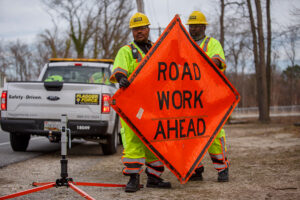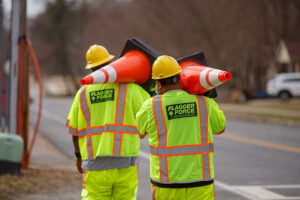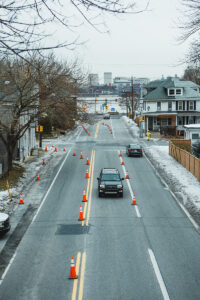Going Beyond Typicals
By: Luke Lazar, Contributor

A tremendous amount of planning needs to take place to identify the correct order of setting out a work zone, which is not identified in the typicals. Photo courtesy of Flagger Force.
Work zones are set up and torn down daily in the short-term traffic control industry, which means safety is always priority number one. The tricky part to this everyday occurrence, is that no roadway is the same. And though this industry has an array of standards, trainings, and resources at the federal, state, and local levels—commonly referred to as typicals—it’s the traffic control professional’s job to adapt to on-the-spot field conditions while complying with this set of standards. This is essential for our community’s safety and efficient travel.
As safety professionals at Flagger Force, we recognize that compliance with typicals is built on a foundation of human performance. A traffic control professional cannot keep the public safe unless they are working safely themselves. With an intense focus on compliance-based safety from a motorist perspective, it is important to not lose sight of this essential human element of performing short-term traffic control. Of course, we train to the typicals, but we also focus on this key differentiator to help with those in-field adaptations.
The job of a traffic control professional is not easy. Modifying a work zone successfully to accommodate curves in roadways, special road signage, or unique community features at a fast pace while still adhering to typicals is a challenge. This means professionals are constantly making critical decisions to keep themselves and those around them safe in work zones. They need to apply the typical and then apply a human perspective to make it all work.
WHAT’S A WORK ZONE? LET’S BREAK IT DOWN

Work zones are set up and torn down daily in the short-term traffic control industry, which means safety is always priority number one. Photo courtesy of Flagger Force.
The U.S. Department of Transportation Federal Highway Administration acknowledges that there is currently no nationally recognized definition of a work zone. Nearly every state has its own unique way of qualifying a work zone, which comes with unique state-specific typicals. The National Highway Traffic Safety Administration roughly defines a work zone as an area where roadwork takes place that may involve lane closures, detours, and moving equipment. Both organizations describe work zones as areas in which construction, maintenance, or utility work takes place that may include stationary or moving traffic control activities.
We all travel and encounter these areas of roadway activity, sometimes daily. Most of us not even knowing that there are five key areas of a work zone:
- Advance Warning Area: warns motorists of changes to the roadway and provides a positive direction to safely navigate
- Transition Area: guides motorists out of their normal travel
- Buffer Area: area of empty space to give an errant vehicle enough time to stop before entering the work
- Work Area: where the work is taking place and the vehicles and equipment involved in the work are
- Termination: guides motorists back into their normal
With no set definition, these elements are necessary for building a work zone. In addition, we’ve identified three key factors to safely and successfully designing a work zone with the above components: communication, sequencing, and risk normalization.
Communication
Communication is essential, especially while working on a live job site. Traffic control professionals must be able to communicate effectively with the crew, the client, and the traveling public.
To set up and control a work zone properly, there must be a robust understanding of the client’s work. Professionals must understand all aspects of their work, such as the number of vehicles involved, type of vehicles involved, whether the work is stationary or mobile, and if the work location will change.
They must also be able to provide firm but courteous direction to motorists to help them safely navigate the work zone. Crew members are often in a position where they are disrupting someone’s normal travel pattern and must be adequately trained in conflict resolution.
Further, they need to communicate with each other effectively. Knowing who will do what at each step and being on the same page is critical. This planning, spotting, and coordinating is essential from the smallest flagging operation to the largest scale freeway/expressway operation.

Modifying a work zone successfully to accommodate curves in roadways, special road signage, or unique community features at a fast pace while still adhering to typicals is a challenge. Photo courtesy of Flagger Force.
Sequencing
Typicals provide a clear picture of how a work zone should be set up, it does not provide a clear order of sequencing for how it should be set up. This leads to potential increased exposure to struck-by hazards that can occur during the setup and tear-down process.
For instance, if cones are deployed before advance warning signs are indicated in either direction, motorists may not know that they need to adjust their path of travel, increasing risk to both themselves and the workers.
A tremendous amount of planning needs to take place to identify the correct order of setting out a work zone, which is not identified in the typicals. Each environment is unique and comes with a variety of side streets, bends, turns, etc., that will determine what the final product will look like. The challenge comes from taking the typical application, which essentially shows the work zone on a “perfect” roadway, and sequencing how to execute a compliant work zone step-by-step in various scenarios.
Risk Normalization
Working on the side of the road is a unique experience. The hazards are constant and require nonstop vigilance and attentiveness. Upon first experiencing it, the intensity of motorists passing by, sometimes at high rates of speed and at times distracted, is overwhelming.
However, with increased exposure to these environments, professionals are susceptible to becoming accustomed to the hazards, and the risks are normalized, leading some to let their guards down. One can easily lose sight of what could happen and act without thinking through the possibilities. Due to this factor, Flagger Force goes to extraordinary lengths to equip our professionals with the human performance tools to combat that tendency. One such tool can be referred to as a Task Hazard Analysis. This simple yet critical concept has three basic steps:
- Pause before acting and allow yourself a moment to think about potential
- Identify the worst possible negative scenario that could occur because of your
- Take steps to reduce or eliminate the possibility that a negative scenario could occur and proceed from
Flagger Force believes that short-term traffic control is not just a job, but an essential career, and it takes the duty to train and develop people into professionals seriously. The job is intense, and the work is challenging. It requires teamwork and watching each other’s backs. All steps require careful consideration and a deep sense of care for fellow colleagues and coworkers. Clearly, it takes going beyond the typical. CS
Luke Lazar is the Vice President of Risk and Safety at Flagger Force (flaggerforce.com).



